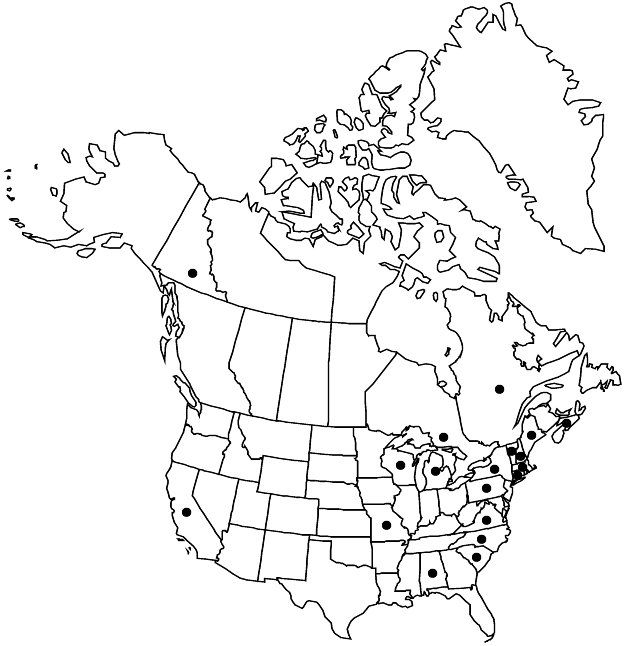Difference between revisions of "Dianthus plumarius subsp. plumarius"
FNA>Volume Importer |
imported>Volume Importer |
||
| (4 intermediate revisions by one other user not shown) | |||
| Line 1: | Line 1: | ||
{{Treatment/ID | {{Treatment/ID | ||
|accepted_name=Dianthus plumarius subsp. plumarius | |accepted_name=Dianthus plumarius subsp. plumarius | ||
| − | |accepted_authority= | + | |accepted_authority= |
|publications= | |publications= | ||
|basionyms= | |basionyms= | ||
| Line 19: | Line 19: | ||
|elevation=0-400 m | |elevation=0-400 m | ||
|distribution=N.S.;Ont.;Que.;Yukon;Ala.;Calif.;Conn.;Maine;Mass.;Mich.;Mo.;N.H.;N.Y.;N.C.;Pa.;S.C.;Vt.;Va.;Wis.;e Europe. | |distribution=N.S.;Ont.;Que.;Yukon;Ala.;Calif.;Conn.;Maine;Mass.;Mich.;Mo.;N.H.;N.Y.;N.C.;Pa.;S.C.;Vt.;Va.;Wis.;e Europe. | ||
| + | |introduced=true | ||
|discussion=<p>Subspecies plumarius is often cultivated and occasionally escapes, perhaps not persisting in the northern part of its range.</p> | |discussion=<p>Subspecies plumarius is often cultivated and occasionally escapes, perhaps not persisting in the northern part of its range.</p> | ||
|tables= | |tables= | ||
| Line 28: | Line 29: | ||
-->{{#Taxon: | -->{{#Taxon: | ||
name=Dianthus plumarius subsp. plumarius | name=Dianthus plumarius subsp. plumarius | ||
| − | + | |authority= | |
| − | |authority= | ||
|rank=subspecies | |rank=subspecies | ||
|parent rank=species | |parent rank=species | ||
| Line 44: | Line 44: | ||
|publication year= | |publication year= | ||
|special status= | |special status= | ||
| − | |source xml=https:// | + | |source xml=https://bitbucket.org/aafc-mbb/fna-data-curation/src/2e0870ddd59836b60bcf96646a41e87ea5a5943a/coarse_grained_fna_xml/V5/V5_331.xml |
|subfamily=Caryophyllaceae subfam. Caryophylloideae | |subfamily=Caryophyllaceae subfam. Caryophylloideae | ||
|genus=Dianthus | |genus=Dianthus | ||
Latest revision as of 22:10, 5 November 2020
Plants cespitose, not matted. Stems erect, simple, 13–40 cm, glabrous, often glaucous. Leaves: sheath (1–)2–4 mm, 1–2 times as long as stem diam.; blade linear, 2–7.5 cm, margins glabrous, often glaucous. Inflorescences open, 2–4-flowered cymes, or sometimes flowers solitary; bracts absent; bracteoles 4, green, obovate, 1/4–1/3 times as long as calyx, herbaceous, apex abruptly acuminate or truncate. Pedicels 8–25 mm. Flowers: calyx 40–45-veined, 14–22 mm, glabrous, lobes ovate, 3–6 mm; petals white or pale pink, often with darker center, bearded, 8–15 mm, apex divided into narrow segments to 1/2 as long as blade. Capsules 23–27 mm, slightly exceeding calyx. Seeds 2.4–3 mm. 2n = 30, 60, 90 (all Europe).
Phenology: Flowering spring and summer.
Habitat: Roadsides, sandy fields
Elevation: 0-400 m
Distribution

Introduced; N.S., Ont., Que., Yukon, Ala., Calif., Conn., Maine, Mass., Mich., Mo., N.H., N.Y., N.C., Pa., S.C., Vt., Va., Wis., e Europe.
Discussion
Subspecies plumarius is often cultivated and occasionally escapes, perhaps not persisting in the northern part of its range.
Selected References
None.